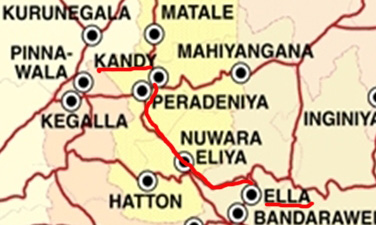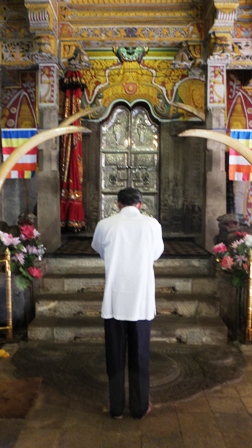Sri Lanka 2013
Episode 7: Kandy - Temples, Trees, Dance

Click the photo above to see an album of photos. Close the window to return to this page
Read Previous Episode 6: Train to Kandy or Next Episode 8: Dambulla|
January 20-22 2013 Kandy
Kandy is another World Heritage site crossed off our list. My
sister Debbie gave us a book listing all the
UNESCO
World Heritage sites and I have been putting dates beside ones
we have visited over the past twelve years, including our own
Rideau Canal running from Ottawa to Lake Ontario. We are doing
very well.
We hired a tuk-tuk driver for a day tour on Sunday to three
14th century
sacred temples within 10 km of Kandy. It is possible to take the
bus to visit the temples but that gets very complicated when the
temples are 3 km apart. The extra money for the tuk-tuk was well
spent.
The first, Embekke Devale, is a center of wood carving in the region, a legacy from the skilled workers who built this small temple. The 16 wooden pillars on the entrance porch are covered with exquisite carvings depicting life of the day. The main sanctumwas typical of the many we visited in Sri Lanka. Of course, Buddha had center stage, but the ceiling and walls, covered with colourful designs and depictions of Buddha and his life, almost steal the show. We were welcomed in, regardless of our religious persuasion, even if there was one of the many daily ceremonies taking place. Sunday means Sunday school for Buddhist children. We arrived at Lankatilake Temple, built on the summit of a rock called Panhalgala, after driving past lush green rice paddies. The beat of drums told us the morning puja ceremony was about to begin. We walked up series of stairs cut into the rock, following several girls and boys, all dressed in their temple whites. The small main sanctum was crowded with worshippers, so we explored the area around the temple until the first prayers were over and the sanctum emptied. Inside were both Buddhist and Hindu deities, a legacy of the two main Sri Lankan religions. Once again, the walls and ceiling were painted with an array of Buddhas and other decorations. Traditionally worshippers are given a meal of rice and lentil curry after puja. The children were enjoying their meal at tables set up under the shade of trees at the base of the rock. Another 3 km ride, which turned out to be a bit longer when we had to detour around the almost constant road repairs which are a feature of Sri Lankan towns, brought us to Gadaladeniya Temple. Built on another rocky outcrop and reached by more stairs cut into the rocks, this temple, like Lankatilake, shows both Buddhist and Hindu influences. There was a large golden seated Buddha inside a South Indian styled temple. Small waterlily pools scattered amongst the several buildings on the site added to the peaceful atmosphere.
All that travelling around the countryside and climbing up stone
steps made us ready for a walk in a garden. Covering 60
hectares, the Peradeniya Botanic Gardens are the largest botanic
gardens in Sri Lanka. Started by the Kandyan Royalty in the 14th
century, they were destroyed by the British when they took control of
the Kingdom of Kandy. The British being fond of gardens, soon
started laying the groundwork for new gardens, which were
officially established in 1843
with
plants brought from Kew Garden, Colombo and other towns in Sri
Lanka. Today the majority of the acreage is an arboretum
with species of trees endemic to Sri Lanka as well as trees from
all India and Asia.
First it was time for some soup and sandwiches in a large, traditional hotel across the street from the Garden entrance. Suitably fortified, we joined the families and many courting couples who make visiting the gardens their favourite week-end activity. We walked over the broad path, leading to expanses of lawn, perfect for picnicking families. Signs next to trees surrounding the Great Circle commemorated the planting by various dignitaries and heads of state of most of the Asian countries and several of the British Royal family. Under almost every tree sat a romantically inclined couple, rather chastely getting to know each other. Courting for Asian couples is not easy with parents and other family jeasously guarding their daughter's reputation, so the popular spot to go is the botanical gardens. In Myanmar couples chose the beautiful commenwealth cemeteries. We continued on down avenues lined with huge Royal Palms to visit the Orchid House and walk past hedges of coleus. It was a sunny day, perfect for our visit. One of the must-see tourist activities in Kandy is a performance of traditional dances and drumming. Our guesthouse hosts recommended we attend the daily 5:30 PM show at the Kandyan Art Association and Cultural Center. There were more tourists at the show than the combined number of tourists we have seen since arriving in Colombo nearly three weeks ago. That said, we managed to get a good seat in the auditorium and really enjoyed the show. The costumes were colourful, the dances, from all parts of Sri Lanka were excellent and the performers were professional quality. Of course, a highlight was the fire walking finale. We were able to move onto the stage for a perfect view of the two men pass flames over their arms, almost eat a flaming torch and walk back and forth on red-hot coals that were on a long tray just below the stage. According to legend, a tooth of the Buddha was snatched from the flames of the Buddha’s funeral pyre in 483 BC and smuggled into Sri Lanka in the 4th century AD, hidden in the hair of a princess. All the major temples in Sri Lanka claim to have had possession of the tooth at one time or another before its final destination in Kandy. Sri Lankans believe that whoever has possession of the tooth has the right to rule the island. The Temple of the Sacred Tooth was constructed mainly under Kandyan Kings from 1687 – 1707 and from 1747-1782 as part of Royal Palace. The Palace is situated next to pretty Kandy Lake, formed in 1807 by Sri Wickrama Rajasinha, the last ruler of the kingdom of Kandy. A small island a short distance from the temple originally housed Sri Wickrama Rajasinha’s personal harem. Of course we had to make a requisite visit to the Temple of the Sacred Tooth while in Kandy. We arrived on Monday just before the 10:30 AM puja ceremony, held in the main sanctum. A fenced off waiting area in from of the entrance to the sanctum was filled with mothers and a few fathers each with a babe in arms, waiting to introduce their children to the Buddhist world. We took our place at the end of a line snaking past a glassed in area where the sacred tooth is held, encased in a Russian Doll series of six gold caskets. I can’t be sure I saw anything as the Tooth Guard gives each person a maximum of 15 seconds to try to catch a glimpse. The main building housed several more shrines in addition to the main sanctum. Several entrances were flanked by elephant tusks and were festooned with precious gifts and Buddha images. One small shrine housed a valuable collection of ola (palm-leaf) manuscripts of Buddhist writings. The Sri Dalada Museum, part of the temple complex, contained golden and bejewelled gifts from Buddhists all over the world, plus photos of the 1998 car bomb damage and subsequent restoration. Outside was an Air Audience Hall with stone pillars carved to look like wood and a pavilion with small oil lamps for devotees to light. There was much to see./div We ended our visit to Kandy in the British Garrison Cemetery. Reading gravestones gives a good idea of the life of the people who lived there in times gone past. This cemetery was filled with gravestones commemorating the lives of babies that did not make it past infanthood and young people felled by various tropical diseases. There were few gravestones for people who lived into old age. Read Previous Episode 6: Train to Kandy or Next Episode 8: Dambulla Read India 2013 Return to Sri Lanka Intro Return to Travels or Introduction |
